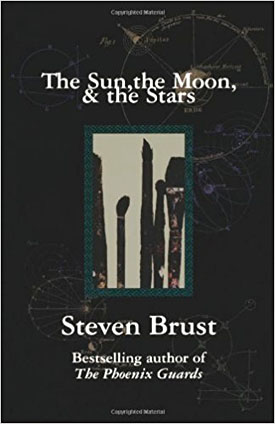 Steven Brust’s The Sun, the Moon, and the Stars is a strangely deceptive novel. It seems, at first, fairly straightforward – a narrative about a group of artists trying to make it, interspersed with sections of a folk tale – but you start to wonder whether it’s really that up front or if Brust is pulling a Gene Wolfe and playing with your head – there seem to be all sorts of clues in the book, but are they?
Steven Brust’s The Sun, the Moon, and the Stars is a strangely deceptive novel. It seems, at first, fairly straightforward – a narrative about a group of artists trying to make it, interspersed with sections of a folk tale – but you start to wonder whether it’s really that up front or if Brust is pulling a Gene Wolfe and playing with your head – there seem to be all sorts of clues in the book, but are they?
We’re going to start our discussion of this novel at the end. There’s a reason for that: the story (or stories) are followed by an afterword, “On the Origin of Folk Beliefs,” that offers a historical/socio-economic take on oral traditions in Hungarian folk tales. This is important because the book itself is composed of two stories, one of which is in the form of a folk tale which is probably Hungarian — at least, it sounds Hungarian: it is the story of three brothers, Csucskari, Hollo, and Baroly, who set out on a quest to find the sun, the moon and the stars so they can bring them home and fix them in the sky — for you see, at this time the skies were dark — and thus win the hand of the king’s daughter in marriage (for one of them, at least) and half the kingdom to boot.
The other story is about Greg, the narrator, and several friends and fellow artists (Greg, you see, is a painter) who share a studio and are trying to decide if they can keep it up: rent comes due on a regular basis, and none of them have gained much in the way of recognition. They’re really on their own quest: as Greg states quite plainly toward the end of the book, “Just in case it’s escaped your attention, what I’ve been trying to do is understand the process of creation.”
This is a rather unusual book for Brust, if for no other reason than that the setting, at least for the main story, is severely limited: it all takes place in the studio, the action, such as it is, is mostly dialogue, and the meat of the quest is embodied in Greg’s thoughts on making art: trying to understand the process of creation, leavened by the personality conflicts inherent in any small group who spend a lot of their time in close quarters.
Thinking back to my own days as an art student, I’m not sure that my compatriots and I had anything like these sorts of discussions, or even anything like Greg’s thoughts on making art. I confess to being very much a right-brain person: when it comes to painting, or working in the darkroom, or even cooking (another of Brust’s frequent motifs), it was much more a matter of “this goes here, this needs to happen here.” Which, thinking about it, is something that Greg does, but with a lot more conscious thought.
One looks for an apparent relationship between the elements, the main narrative and the folk tale. If it’s there, in any sort of one-to-one relationship, it’s much too subtle for me: the segments of the folk tale don’t seem to link in any obvious way to the segments of the studio story. Unless, of course, the Brust is using the slaying of dragons (of course there are dragons to be slain) as a metaphor for the problems of artistic creation.
The same can be said for the chapter headings, each of which is the title of a painting, mostly pre-twentieth century, but a few more modern works. Those that I remember — The Burial of Count Orgaz, for example – don’t really seem to illustrate events in the chapters they head. (No, I was not about to haul out my Jansen and look them all up.)
Well, so much for all those clues.
In the final analysis, it’s a talky book, as you might have gathered: there’s not a lot of physical action going on, and what there is is related baldly and concisely. It’s about ideas, about processes, and about the quest – and come to think of it, it’s the quest that is the bridge, the folk tale serving as a big sign that says “Look here, this is what’s happening.” Metaphorically, of course.
There has been a tendency on the part of some commentators to link this book with the song cycle Songs from “The Gypsy” and Brust’s later collaboration with Megan Lindholm, The Gypsy. (I’m not pointing fingers — I’ve done it myself.) On rereading them both, once again, if there’s a link it’s very tenuous. It may be just that the folk tale is about the same three brothers who appear in The Gypsy, although in the latter book the story and milieu are much looser, much more impressionistic, and the story itself much wider in scope.
At any rate, The Sun, the Moon, and the Stars is certainly worth reading, especially if you’re curious about what goes on in an artist’s head while he’s working.
(Orb, 1987)
